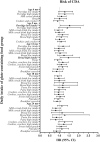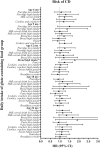Sources of dietary gluten in the first 2 years of life and associations with celiac disease autoimmunity and celiac disease in Swedish genetically predisposed children: The Environmental Determinants of Diabetes in the Young (TEDDY) study
- PMID: 35394004
- PMCID: PMC9348971
- DOI: 10.1093/ajcn/nqac086
Sources of dietary gluten in the first 2 years of life and associations with celiac disease autoimmunity and celiac disease in Swedish genetically predisposed children: The Environmental Determinants of Diabetes in the Young (TEDDY) study
Abstract
Background: High gluten intake is associated with increased risk of celiac disease (CD) in children at genetic risk.
Objectives: We aimed to investigate if different dietary gluten sources up to age 2 y confer different risks of celiac disease autoimmunity (CDA) and CD in children at genetic risk.
Methods: Three-day food records were collected at ages 6, 9, 12, 18, and 24 mo from 2088 Swedish genetically at-risk children participating in a 15-y follow-up cohort study on type 1 diabetes and CD. Screening for CD was performed with tissue transglutaminase autoantibodies (tTGA). The primary outcome was CDA, defined as persistent tTGA positivity. The secondary outcome was CD, defined as having a biopsy specimen showing Marsh score ≥ 2 or an averaged tTGA level ≥ 100 Units. Cox regression adjusted for total gluten intake estimated HRs with 95% CIs for daily intake of gluten sources.
Results: During follow-up, 487 (23.3%) children developed CDA and 242 (11.6%) developed CD. Daily intake of ≤158 g porridge at age 9 mo was associated with increased risk of CDA (HR: 1.53; 95% CI: 1.05, 2.23; P = 0.026) compared with no intake. A high daily bread intake (>18.3 g) at age 12 mo was associated with increased risk of both CDA (HR: 1.47; 95% CI: 1.05, 2.05; P = 0.023) and CD (HR: 1.79; 95% CI: 1.10, 2.91; P = 0.019) compared with no intake. At age 18 mo, milk cereal drink was associated with an increased risk of CD (HR: 1.16; 95% CI: 1.00, 1.33; P = 0.047) per 200-g/d increased intake. No association was found for other gluten sources up to age 24 mo and risk of CDA or CD.
Conclusions: High daily intakes of bread at age 12 mo and of milk cereal drink during the second year of life are associated with increased risk of both CDA and CD in genetically at-risk children.
Keywords: HLA; TEDDY; celiac disease; children; gluten foods.
© The Author(s) 2022. Published by Oxford University Press on behalf of the American Society for Nutrition.
Figures



References
-
- Sollid LM. Coeliac disease: dissecting a complex inflammatory disorder. Nat Rev Immunol. 2002;2(9):647–55. - PubMed
-
- King JA, Jeong J, Underwood FE, Quan J, Panaccione N, Windsor JWet al. . Incidence of celiac disease is increasing over time: a systematic review and meta-analysis. Am J Gastroenterol. 2020;115(4):507–25. - PubMed
-
- Bradauskiene V, Vaiciulyte-Funk L, Martinaitiene D, Andruskiene J, Verma AK, Lima JPMet al. . Wheat consumption and prevalence of celiac disease: correlation from a multilevel analysis. Crit Rev Food Sci Nutr. 2021;1–15. - PubMed
Publication types
MeSH terms
Substances
Grants and funding
- U01 DK063821/DK/NIDDK NIH HHS/United States
- UC4 DK063836/DK/NIDDK NIH HHS/United States
- UC4 DK112243/DK/NIDDK NIH HHS/United States
- U01 DK063865/DK/NIDDK NIH HHS/United States
- U01 DK128847/DK/NIDDK NIH HHS/United States
- U01 DK063861/DK/NIDDK NIH HHS/United States
- UC4 DK095300/DK/NIDDK NIH HHS/United States
- UC4 DK063865/DK/NIDDK NIH HHS/United States
- UC4 DK063863/DK/NIDDK NIH HHS/United States
- UC4 DK100238/DK/NIDDK NIH HHS/United States
- UL1 TR002535/TR/NCATS NIH HHS/United States
- UC4 DK063821/DK/NIDDK NIH HHS/United States
- UC4 DK117483/DK/NIDDK NIH HHS/United States
- HHSN267200700014C/DK/NIDDK NIH HHS/United States
- U01 DK063836/DK/NIDDK NIH HHS/United States
- U01 DK124166/DK/NIDDK NIH HHS/United States
- U01 DK063829/DK/NIDDK NIH HHS/United States
- U01 DK063790/DK/NIDDK NIH HHS/United States
- U01 DK063863/DK/NIDDK NIH HHS/United States
- UC4 DK063829/DK/NIDDK NIH HHS/United States
- UL1 TR000064/TR/NCATS NIH HHS/United States
- UC4 DK063861/DK/NIDDK NIH HHS/United States
- UC4 DK106955/DK/NIDDK NIH HHS/United States
LinkOut - more resources
Full Text Sources
Medical
Research Materials

